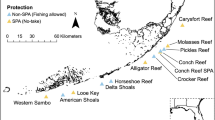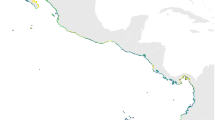Abstract
Six cerithiid snail species occur on rocky intertidal flats along the Sinai coasts of the Red Sea: Clypeomorus moniliferum, Cerithium caeruleum, C. scabridum, C. columna, Clypeomorus tuberculatum and Cerithium echinatum. The present study, conducted at 22 stations covering almost the whole length of Sinai, covered the 4 yr period from October 1972 to August 1976, and describes the habitat occupancy of 5 of these species (C. echinatum is excluded for lack of data). Several of these species (sometimes all) often occur together, and in such cases are distincly segregated by habitat. However all species considerably overlap in their distribution along the axes of four major interrelated abiotic gradients, thus excluding the possibility that habitat segregation is determined by larval settlement preferences. Other distributional patterns observed at some sites, such as lack of overlap or contact between belts of the various species and the relative abundance of food available to all species, make postlarval competitive interactions unlikely. The existence and the degree of proximity of a coral reef with its associated predatory fishes, influence the cerithiids' distributional patterns. Differences between the cerithiid species in their vulnerability to fish predation, associated with differences between sites in the abundance and the accessibility of predatory fishes, and in the availability of refuges for each cerithiid species, can satisfactorily explain the observed distributional patterns including co-occurrence with habitat segregation. It is proposed that habitat segregation is caused by predation on young stages by generalist fishes which may totally eliminate a certain species at a given site; the same site may provide refuges for recruits of another species, allowing these to survive to an advanced age. In general, the flat's structural complexity is associated with its diversity of refuges from predation, and hence with the number of co-existing species. This mechanism for co-existence and habitat segregation in tropical Cerithiidae may also be instrumental in maintaining the high species diversity of other tropical benthic communities.
Similar content being viewed by others
Literature Cited
Ayal, Y.: Geographical distribution, ecological niche and the strategy of reproduction of the colonizer Cerithium scabridum Phil. (Gastropoda: Prosobranchia) as compared with those of some other sympatric non-colonizing congeneric species, 210 pp. Unpublished Ph. D. dissertation, Hebrew University of Jerusalem 1978
Ayal, Y. and U. N. Safriel: Intertidal zonation and key-species associations of the flat rocky shores of Sinai, used for scaling environmental variables affecting cerithiid gastropods. Israel J. Zool. 29, 110–124 (1980)
Ayal, Y. and U. N. Safriel: Species composition, geographical distribution and habitat characteristics of rocky intertidal Cerithiidae (Gastropoda: Prosobranchia) along the Red Sea shores of Sinai. Israel J. Malac. (Argamon) 7, 53–72 (1981)
Bakus, G. J.: The feeding habits of fishes and primary production at Eniwetok, Marshall Islands. Micronesica 3, 135–149 (1967)
Butrus, G. A.: Fishes of the Red Sea. Oceanogr. mar. Biol. A. Rev. 9, 221–348 (1971)
Connell, H. J.: Community interactions on marine rocky intertidal shores. A. Rev. Ecol. Syst. 3, 169–192 (1972)
Connell, H. J.: Some mechanisms producing structure in natural communities: a model and evidences from field experiments. In: Ecology and evolution of communities, pp 460–490. Ed. by M. L. Cody and J. Diamond. Cambridge, Massachusetts: Belknap 1975
Genin, A.: Locomotion, biotic and abiotic factors and the lower boundary of a snail's intertidal distribution, 82 pp. Unpublished M. Sc. dissertation. [In Hebrew]. Hebrew University of Jerusalem 1981
Goldman, B. and F. H. Talbot: Aspects of the ecology of coral reef fishes. In: Biology and geology of coral reefs. Vol. III. Biology, pp 125–154. Ed. by O. A. Jones and R. Endean, New York: Academic Press 1976
Hassell, M. P.: The dynamics of arthropod predator-prey systems, 237 pp. Princeton: Princeton University Press 1978
Heck, K. L.: Some determinants of the composition and abundance of motile macroinvertebrate species in tropical and temperate turtlegrass (Thalassia testudinum) meadows. J. Biogeogr. 6, 183–200 (1979)
Hiatt, R. W. and D. W. Strasburg Ecological relationships of fish fauna on coral reefs of the Marshall Islands. Ecol. Monogr. 30, 65–127 (1960)
Houbrick, R. S.: The genus Cerithium in the Western Atlantic. Johnsonia 5, 33–84 (1974a)
Houbrick, R. S.: Growth studies on the genus Cerithium (Gastropoda: Prosobranchia) with notes on ecology and microhabitats. Nautilus 88, 14–27 (1974b)
Jackson, J. B. C.: The ecology of the molluscs of Thalassia communities, Jamaica, West Indies. II. Molluscan population variability along an environmental stress gradient. Mar. Biol. 14, 304–337 (1972)
James, D. B. and J. S. Pearse: Echinoderms from the Gulf of Suez and northern Red Sea. J. mar. biol. Ass. India 11, 78–125 (1969)
Janzen, D. H.: Herbivores and the number of tree species in tropical forests. Am. Nat. 104, 501–528 (1970)
Kohn, A. J.: Diversity, utilization of resources, and adaptive radiation in shallow-water marine invertebrates of tropical oceanic islands. Limnol. Oceanogr. 16, 332–348 (1971)
Lack, D.: Ecological isolation in birds, 404 pp. Oxford: Blackwell 1971
Leviten, P. J.: Resource partitioning by predatory gastropods of the genus Conus on subtidal Indo-Pacific coral reefs: the significance of prey size. Ecology 59, 614–631 (1978)
May, R. M. and R. H. MacArthur: Niche overlap as a function of environmental variability. Proc. natn. Acad. Sci. U.S.A. 69, 1109–1113 (1972)
Mileikovsky, S. A.: Types of larval development in marine bottom invertebrates, their distribution and ecological significance: a re-evaluation. Mar. Biol. 10, 193–213 (1971)
Morcos, S. A.: Oceanography of the Red Sea. Oceanogr. mar. Biol. A. Rev. 8, 73–202 (1970)
Newman, W. A.: The paucity of intertidal barnacles in the tropical Western Pacific. Veliger 2, 89–94 (1960)
Nicotri, M. E.: Grazing effects of four marine intertidal herbivores on the microflora. Ecology 58, 1020–1032 (1977)
Paine, R. T.: Food-web complexity and species diversity. Am. Nat. 100, 65–75 (1966)
Palmer, A. R.: Fish predation and the evolution of gastropod shell sculpture: experimental and geographical evidence. Evolution, Lawrence, Kansas 33, 697–713 (1979)
Randall, J. E.: Food habits of reef fishes of the West Indies. Stud. trop. Oceanogr., Miami 5, 665–847 (1967)
Rohde, K. and R. Sandland Factors influencing clustering in the intertidal snail Cerithium moniliferum. Mar. Biol. 30, 203–215 (1975)
Roughgarden, J.: Species packing and the competition function, with illustration from coral reef fishes. Theor. Popul. Biol. 5, 163–186 (1974)
Safriel, U. N.: Ecological segregation, polymorphism and natural selection in two intertidal gastropods of the genus Nerita at Elat (Red Sea, Israel). Israel J. Zool. 18, 205–231 (1969)
Safriel, U. N., T. Felsenburg and A. Gilboa: The distribution of Brachidontes variabilis (Kraus) along the Red Sea coasts of Sinai. Israel J. Malac (Argamon) 7, 31–43 (1980a)
Safriel, U. N., A. Gilboa and T. Felsenburg: Distribution of rocky intertidal mussles in the Red Sea coasts of Sinai, the Suez Canal and the Mediterranean coasts of Israel, with special reference to recent colonizers. J. Biogeogr. 7, 39–62 (1980b)
Sloan, N. A.: Microhabitat and resource utilization in cryptic rocky intertidal echinoderms of Aldabra Atoll, Seychelles. Mar. Biol. 54, 269–279 (1979)
Slobodkin, L. B.: The growth and regulation of animal numbers, 184 pp. New York: Holt, Rinehart & Winston 1961
Stephenson, W. and R. B. Searles: Experimental studies of the ecology of intertidal environments at Heron Island. I. Exclusion of fishes from beachrocks. Aust. J. mar. Freshwat. Res. 11, 241–267 (1960)
Taylor, J. D.: Intertidal zonation at Aldabra Atoll. Phil. Trans. R. Soc. (Ser. B) 260, 173–213 (1971)
Taylor, J. D.: Habitat, abundance and diet of muricacean gastropods at Aldabra Atoll. J. Linn. Soc. (Zool.) 59, 155–193 (1976)
Thorson, G.: Reproductive and larval ecology of marine bottom invertebrates. Biol. Rev. 25, 1–45 (1950)
Vermeij, G. J.: Marine faunal dominance and molluscan shell forms. Evolution, Lawrence, Kansas 28, 656–664 (1974)
Vermeij, G. J.: Biogeography and adaptation, 332 pp. Cambridge Massachusetts: Harvard University Press 1978
Whittaker, R. H., S. A. Levin and R. B. Root: Niche, habitat and ecotope. Am. Nat. 107, 321–338 (1973)
Author information
Authors and Affiliations
Additional information
Communicated by J. M. Pérès, Marseille
Paper No. 12 in the series “Colonization of the Eastern Mediterrancan by Red Sea species immigrating through the Suez Canal”
Rights and permissions
About this article
Cite this article
Ayal, Y., Safriel, U.N. Role of competition and predation in determining habitat occupancy of Cerithiidae (Gastropoda: Prosobranchia) on the rocky, intertidal, Red Sea coasts of Sinai. Mar. Biol. 70, 305–316 (1982). https://doi.org/10.1007/BF00396849
Accepted:
Issue Date:
DOI: https://doi.org/10.1007/BF00396849




